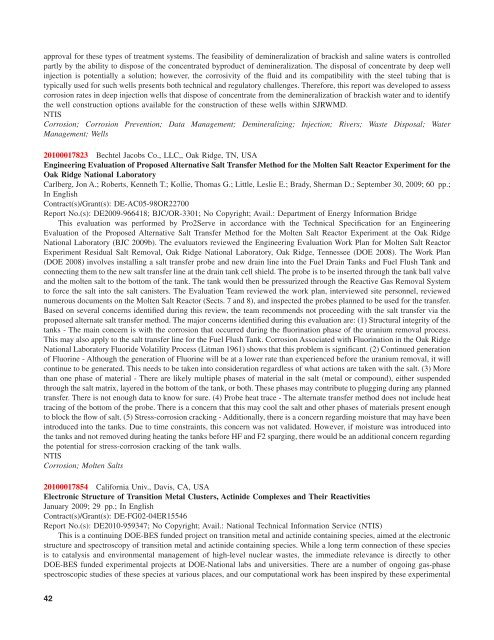NASA Scientific and Technical Aerospace Reports - The University ...
NASA Scientific and Technical Aerospace Reports - The University ...
NASA Scientific and Technical Aerospace Reports - The University ...
Create successful ePaper yourself
Turn your PDF publications into a flip-book with our unique Google optimized e-Paper software.
approval for these types of treatment systems. <strong>The</strong> feasibility of demineralization of brackish <strong>and</strong> saline waters is controlled<br />
partly by the ability to dispose of the concentrated byproduct of demineralization. <strong>The</strong> disposal of concentrate by deep well<br />
injection is potentially a solution; however, the corrosivity of the fluid <strong>and</strong> its compatibility with the steel tubing that is<br />
typically used for such wells presents both technical <strong>and</strong> regulatory challenges. <strong>The</strong>refore, this report was developed to assess<br />
corrosion rates in deep injection wells that dispose of concentrate from the demineralization of brackish water <strong>and</strong> to identify<br />
the well construction options available for the construction of these wells within SJRWMD.<br />
NTIS<br />
Corrosion; Corrosion Prevention; Data Management; Demineralizing; Injection; Rivers; Waste Disposal; Water<br />
Management; Wells<br />
20100017823 Bechtel Jacobs Co., LLC,, Oak Ridge, TN, USA<br />
Engineering Evaluation of Proposed Alternative Salt Transfer Method for the Molten Salt Reactor Experiment for the<br />
Oak Ridge National Laboratory<br />
Carlberg, Jon A.; Roberts, Kenneth T.; Kollie, Thomas G.; Little, Leslie E.; Brady, Sherman D.; September 30, 2009; 60 pp.;<br />
In English<br />
Contract(s)/Grant(s): DE-AC05-98OR22700<br />
Report No.(s): DE2009-966418; BJC/OR-3301; No Copyright; Avail.: Department of Energy Information Bridge<br />
This evaluation was performed by Pro2Serve in accordance with the <strong>Technical</strong> Specification for an Engineering<br />
Evaluation of the Proposed Alternative Salt Transfer Method for the Molten Salt Reactor Experiment at the Oak Ridge<br />
National Laboratory (BJC 2009b). <strong>The</strong> evaluators reviewed the Engineering Evaluation Work Plan for Molten Salt Reactor<br />
Experiment Residual Salt Removal, Oak Ridge National Laboratory, Oak Ridge, Tennessee (DOE 2008). <strong>The</strong> Work Plan<br />
(DOE 2008) involves installing a salt transfer probe <strong>and</strong> new drain line into the Fuel Drain Tanks <strong>and</strong> Fuel Flush Tank <strong>and</strong><br />
connecting them to the new salt transfer line at the drain tank cell shield. <strong>The</strong> probe is to be inserted through the tank ball valve<br />
<strong>and</strong> the molten salt to the bottom of the tank. <strong>The</strong> tank would then be pressurized through the Reactive Gas Removal System<br />
to force the salt into the salt canisters. <strong>The</strong> Evaluation Team reviewed the work plan, interviewed site personnel, reviewed<br />
numerous documents on the Molten Salt Reactor (Sects. 7 <strong>and</strong> 8), <strong>and</strong> inspected the probes planned to be used for the transfer.<br />
Based on several concerns identified during this review, the team recommends not proceeding with the salt transfer via the<br />
proposed alternate salt transfer method. <strong>The</strong> major concerns identified during this evaluation are: (1) Structural integrity of the<br />
tanks - <strong>The</strong> main concern is with the corrosion that occurred during the fluorination phase of the uranium removal process.<br />
This may also apply to the salt transfer line for the Fuel Flush Tank. Corrosion Associated with Fluorination in the Oak Ridge<br />
National Laboratory Fluoride Volatility Process (Litman 1961) shows that this problem is significant. (2) Continued generation<br />
of Fluorine - Although the generation of Fluorine will be at a lower rate than experienced before the uranium removal, it will<br />
continue to be generated. This needs to be taken into consideration regardless of what actions are taken with the salt. (3) More<br />
than one phase of material - <strong>The</strong>re are likely multiple phases of material in the salt (metal or compound), either suspended<br />
through the salt matrix, layered in the bottom of the tank, or both. <strong>The</strong>se phases may contribute to plugging during any planned<br />
transfer. <strong>The</strong>re is not enough data to know for sure. (4) Probe heat trace - <strong>The</strong> alternate transfer method does not include heat<br />
tracing of the bottom of the probe. <strong>The</strong>re is a concern that this may cool the salt <strong>and</strong> other phases of materials present enough<br />
to block the flow of salt. (5) Stress-corrosion cracking - Additionally, there is a concern regarding moisture that may have been<br />
introduced into the tanks. Due to time constraints, this concern was not validated. However, if moisture was introduced into<br />
the tanks <strong>and</strong> not removed during heating the tanks before HF <strong>and</strong> F2 sparging, there would be an additional concern regarding<br />
the potential for stress-corrosion cracking of the tank walls.<br />
NTIS<br />
Corrosion; Molten Salts<br />
20100017854 California Univ., Davis, CA, USA<br />
Electronic Structure of Transition Metal Clusters, Actinide Complexes <strong>and</strong> <strong>The</strong>ir Reactivities<br />
January 2009; 29 pp.; In English<br />
Contract(s)/Grant(s): DE-FG02-04ER15546<br />
Report No.(s): DE2010-959347; No Copyright; Avail.: National <strong>Technical</strong> Information Service (NTIS)<br />
This is a continuing DOE-BES funded project on transition metal <strong>and</strong> actinide containing species, aimed at the electronic<br />
structure <strong>and</strong> spectroscopy of transition metal <strong>and</strong> actinide containing species. While a long term connection of these species<br />
is to catalysis <strong>and</strong> environmental management of high-level nuclear wastes, the immediate relevance is directly to other<br />
DOE-BES funded experimental projects at DOE-National labs <strong>and</strong> universities. <strong>The</strong>re are a number of ongoing gas-phase<br />
spectroscopic studies of these species at various places, <strong>and</strong> our computational work has been inspired by these experimental<br />
42

















